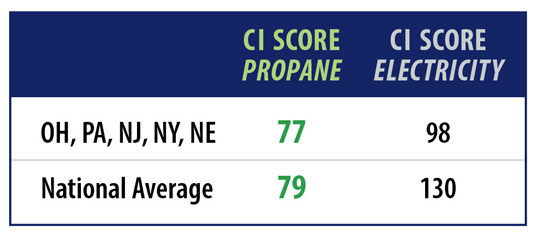The First Parade for Propane

Some Apples Are Green.
Some apples are green. They’re not red apples made to look green!
Most electricity isn’t green, so why are many people fooled into thinking electricity is clean energy?
We’ll get to the U.S. in a minute, but the reality is that coal is the dominant fuel source for electricity generation in the world. In fact, global coal production reached its highest level ever recorded last year, largely due to coal production and consumption in China which accounts for more than 50% of the world’s total. Even India now consumes more coal than North America and Europe combined.
I understand the current thirst for coal. Cost and availability are the primary factors that determine quality of life for people in many parts of the world. Global concerns over CO2 emissions won’t top quality of life, especially in less developed countries where many people don’t have electricity.
But here in the U.S.? Can’t we value cleaner fuels over dirtier fuels? What’s the downside to that approach?
Natural Gas Is Cleaner Than Coal.
First, we should agree that "cleaner” is better than “dirtier” unless you’re talking about 4x4 off-road mud bogging.
Coal is roughly 2.3 times dirtier than natural gas in terms of carbon intensity (2,274 lbs. of CO2 per MWh versus 980 lbs. of CO2 per MWh). Nearly every U.S. state recognizes that and has been steadily reducing the carbon intensity of its power generation for many years now. In small part, that’s due to nuclear power and renewables. In large part, that’s due to natural gas.
High demand for natural gas-fired electricity generation both here and abroad (about 42% of the U.S. national power source mix) requires high levels of natural gas production which results in abundant quantities of natural gas liquids, including propane.
Most of the propane made in the U.S. comes from natural gas processing plants located in the major shale areas of the country.
Propane Is Often Cleaner Than Electricity.
To use an example, the carbon intensity score of traditional propane from Ohio to Maine is around 77. But the carbon intensity score for electricity is around 98 (using the weighted average by population, which is around 70 million people).
Nationally, the statistics are even worse for electricity. On the national level the CI score for electricity is around 130, natural gas is around 80 and propane is around 79.

These scores are based on what’s called a “life-cycle analysis” or total carbon footprint, and it follows carbon intensities and efficiencies from the extraction or creation of the energy source right to your home.
So, why don’t more U.S. states value cleaner fuels like propane over dirtier fuels?
Politicians should be giving propane the same incentives they offer electricity so that there is a level playing field.
A Parade for Propane.
There are few sources of global energy that are cleaner in terms of carbon intensity (or more reliable, or more readily available) to improve the quality of life in every way possible for humankind than natural gas and its prized “offspring” propane.
Not coal … not diesel … not heating oil … not gasoline … and, in many cases, not electricity.
So, where are the parades for propane?
More Renewable Diesel (rD) and Sustainable Aviation Fuels (SAF) Plants Mean More Renewable Propane (rP).
Imagine that you’re having coffee with an electrification aficionado.
Electrification Aficionado: Yes, I’ll admit that everything you’re saying about natural gas being cleaner than coal is true. I’ll also acknowledge that most of the electricity in the U.S. is generated from natural gas and that propane is often cleaner than electricity! But it’s a marathon, not a sprint, right? And the percentage of electricity that’s generated from renewables keeps increasing.
You: Exactly. It’s a marathon, not a sprint. To your point, renewable propane is a by-product of Renewable Diesel and Sustainable Aviation Fuel production. It has an extremely low carbon intensity score between 20 and 45 depending on the renewable feedstock so it makes an already clean, affordable, and reliable fuel like propane even cleaner. And the production of renewable propane keeps increasing. So yes, the future is bright!
Electrification Aficionado: At last, something we can both agree on.
The Skinny
In most states, and in most instances, propane is cleaner than electricity.
At Ray Energy, we’re proud to sell a clean, affordable, and reliable fuel like propane that’s part of the global solution toward reducing CO2 emissions. We’re also proud that we were the first midstream propane supplier to bring renewable propane into the Northeast, making a clean energy source for the future even cleaner.
Let’s schedule a parade for propane!
Get Stephen's insights on propane delivered to your inbox every month. Sign up for our monthly newsletter here.
For more frequent updates and industry news, join us on LinkedIn.
NOTE: The views and opinions expressed herein are solely those of the author, unless attributed to a third-party source, and do not necessarily reflect the views of Ray Energy Corp, its affiliates, or its employees. The information set forth herein has been obtained or derived from sources believed by the author to be reliable. However, the author does not make any representation or warranty, express or implied, as to the information’s accuracy or completeness, nor does the author recommend that the attached information serve as the basis of any buying decision and it has been provided to you solely for informational purposes.
© 2011-2024 Ray Energy Corp. All rights reserved. Any reproduction, representation, adaptation, translation, and/or transformation, in whole or in part by whatsoever process, of this site or of one or several of its components, is forbidden without the express written authorization from Ray Energy Corp.

